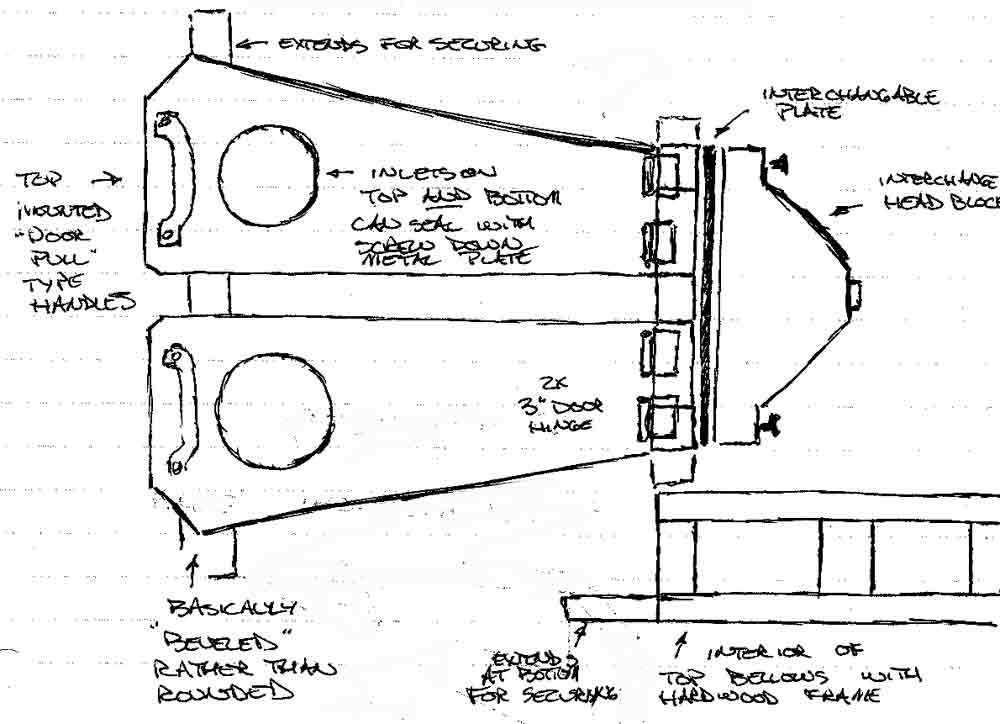
Mark 2 Smelter Bellows, calculated 10/8/11

| Target Volumes | LpM | ||||||
| Smelter SIZE | area | 1.2 | 1.5 | ||||
| cm | cm2 | LpC2 | LpC2 | ||||
| 20 | 314 | 375 | 470 | ||||
| 25 | 491 | 590 | 735 | typical dia. | |||
| 30 | 707 | 850 | 1060 | ||||
| 35 | 962 | 1150 | 1440 | ||||
| TEST | |||||||
| Operator | No Load | with Load | |||||
| Gage A | Gage B | average | Gage A | Gage B | average | ||
| Neil | Speed | 37 | 43 | 40 | 38 | 48 | 43 |
| Volume | 313 | 363 | 338 | 321 | 406 | 363 | |
| Marcus | Speed | 28 | 35 | 31.5 | 40 | 42 | 41 |
| Volume | 237 | 296 | 266 | 338 | 355 | 346 | |
| Darrell | Speed | 40 | 48 | 44 | 39 | 50 | 44.5 |
| Volume | 338 | 406 | 372 | 330 | 423 | 376 | |
| Thomas | Speed | 50 | 55 | 52.5 | 36 | 40 | 38 |
| Volume | 423 | 465 | 444 | 304 | 338 | 321 | |
| Gus | Speed | 39 | 35 | 37 | 37 | 39 | 38 |
| Volume | 330 | 296 | 313 | 313 | 330 | 321 | |
| Group Average | Speed | 38 | 42 | ||||
| Volume | 322 | 352 | |||||
| Standard | |||||||
| Neil's math | 1 | KPH | is | 1666.66667 | cm/min | ||
| 2.54 | cm pipe | is | 5.06707479 | cm2 | |||
| 1 | cm3/min | is | 0.001 | LpM | |||
| 1 | KPH | is | 8.44512465 | LpM | |||
| SPEED | to VOLUME | for 2.5 dia. | |||||
| KpH | LpM | x 8.45 | |||||
| 47 | 400 | ||||||
| 53 | 450 | ||||||
| 59 | 500 | ||||||
| 65 | 550 | ||||||
| 71 | 600 | ||||||
| 77 | 650 | ||||||
| 83 | 700 | ||||||
| 89 | 750 | ||||||
| 95 | 800 | typical use | |||||
| 101 | 850 | ||||||
| 107 | 900 | ||||||
| 112 | 950 | ||||||
| 118 | 1000 | ||||||
| 124 | 1050 | ||||||
| 130 | 1100 | ||||||
| 142 | 1200 | ||||||
| 154 | 1300 |
Notes:
Two different 'wind surfer' type vane aneonometers were used. This primarily because a descrepancy between the recorded values for identical air flows had been encountered. It is not known if this is the result of wear in the older of the two units, or just because of functional inaccuracy with the type of equipment used.
The first use cycle was undertaken when the furnace was being used with a small handful of wood splints, so can be considered to be 'open'. The second series was with the furnace holding a full charge of ungraded charcoal (indicated as 'with load'). In a fullly functional furnace, the charcoal would be graded down to .5 - 2.5 cm pieces, plus additionally there would be some quantity of smaller sized ore particles in place in the shaft. Both of these elements would likely increase the load force required to deliver air via the bellows pipe.
Although the individuals taking part in this test were told to 'use a comfortable
rhythm', both Marcus and Darrell had taken part in the Vinland 4 and Vinland
5 smelts - which where entirely bellows driven (using this same bellows). Darrell
quite specifically attempted to match the same delivery as had been used for
those experiments. In so much as his volumes appear to match fairly close to
those of both Neil and Marcus (who also have bellows experience with this equipment),
it may be reasonable that those numbers are fairly indicative of actual full
smelt volumes.
Last Updated on 10/18/11 / Published 10/31/11
By Darrell Markewitz, Neil Peterson
Email: smelt@warehamforge.ca